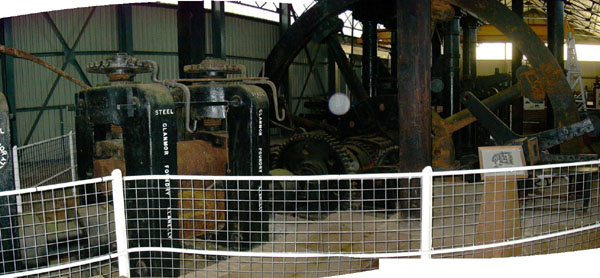The hot mill must have been the centerpiece of Kidwelly, since its process was most thoroughly described in the museum. This mosaic shows one mill, some gears and couplers, and the flywheel. The steam engine is beyond the flywheel, and drove a line of mills ganged together on both sides of the engine. The drive shaft coming out of the engine drove the bottom roller of this mill. That roller was coupled to the bottom roller of the next mill, and so forth. There were another set of mills on the other side of the steam engine, off the picture to the right. Each mill would have a rollerman, a behinder, a doubler, a shearer, and a furnaceman. The furnaceman would heat the iron or steel plate to "blood-red" temperature in a furnace. None of the furnaces have survived, but an old photo shows the hot mills building with six smokestacks on each side of the building. The furnaceman would pass the hot iron to the rollerman, who would feed it into the mill. The behindman would pass the rolled plate back over the top of the mill to the rollerman. The doubler would fold the hot plate in half, step on it to crease it, and pass it to the shearer. The shearer would put the creased side of the doubled plate into the shears (one is shown on the right behind the sign). This would crimp the crease and shear off the uneven side. The doubled, sheared plate would then be passed to the next mill for the same process. Each iron bar entering the process would be doubled 8 times.
NEXT
LIST
